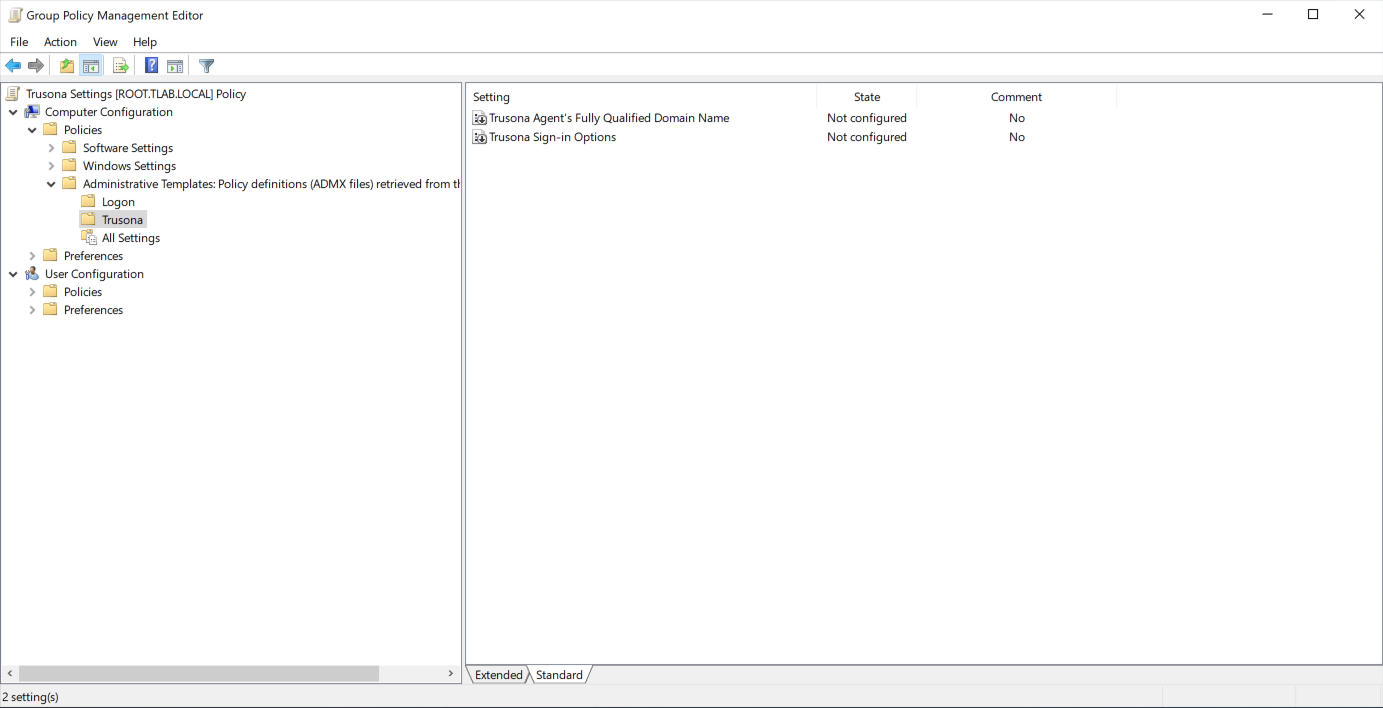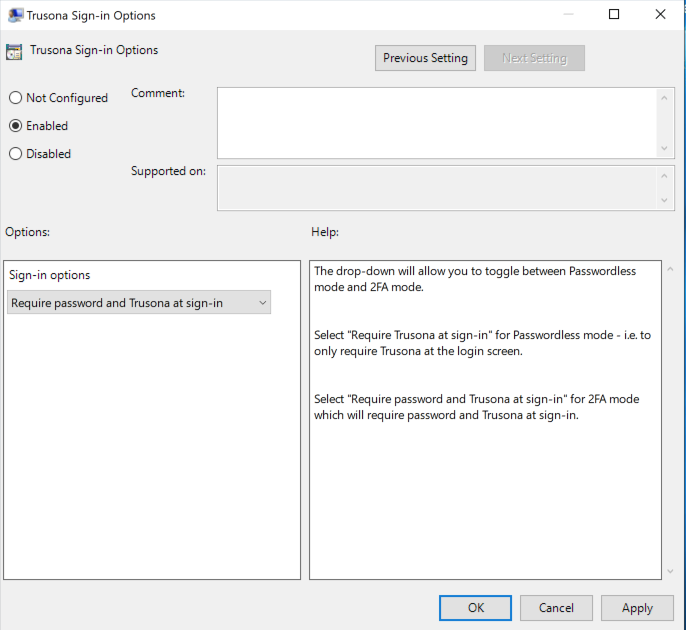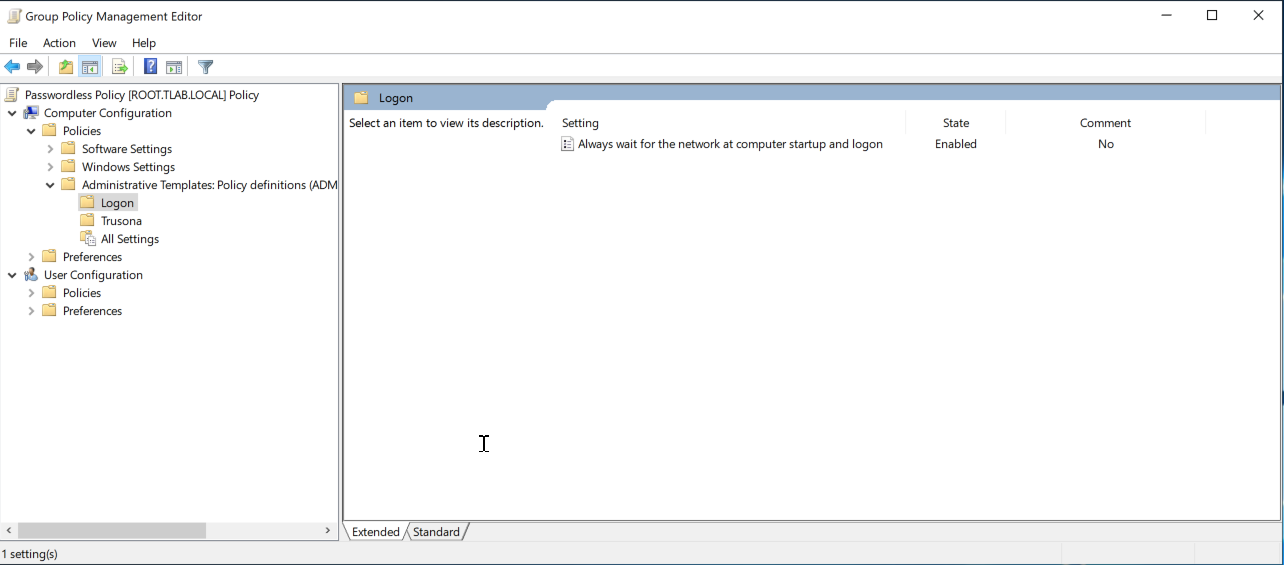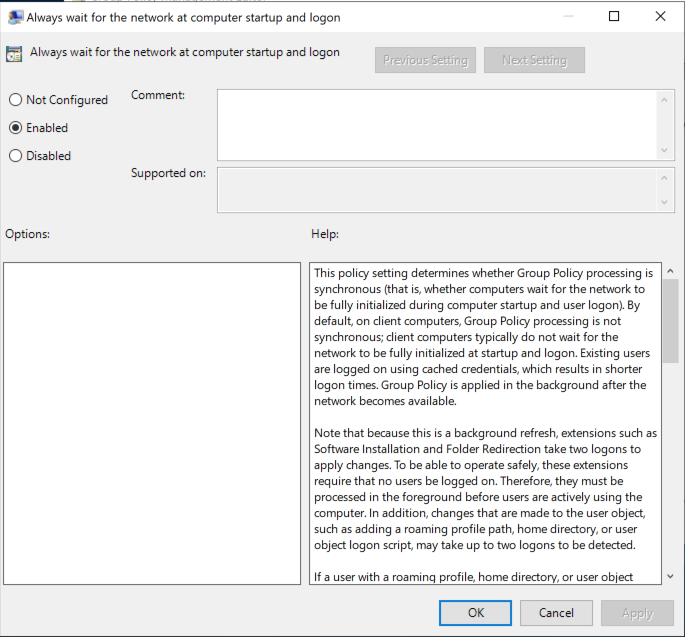- 1. Install Active Directory Certificate Services (ADCS)
- 2. Configure Active Directory Certificate Services
- 3. Configure Active Directory Server Authentication Enrollment Settings
- 4. Server KDC Enrollment
- 5. Agent Service Installation
- 6. Credential Provider Installation
1. Install Active Directory Certificate Services (ADCS)
1.1. ADCS installation Steps
- Login as an Enterprise Administrator
- Open the Server Manager on the Active Directory instance to be used
- On the right hand side, click on
Manageand selectAdd Roles and Features - Next, for installation type, select
Role-based or feature-based installation - Select the target server from the provided selection
- Check off
Active Directory Certificate Servicesfrom the list of availableServer Roles - Click on
Add Featureson the screen that pops up - Accept the pre-selected values on the
featureslist - Click on
Next - In the list of
Role Services, check offCertification Authorityand click onNext - Check off the option to restart the destination server automatically if required
- Finally, review previously made selections then click on
Install - Installation should complete successfully in a short while. When done click on
Close
1.2. ADCS installation walk through
Open the Server Manager on the Active Directory instance to be used.

On the right hand side, click on Manage and select Add Roles and Features:

Next, for installation type, select Role-based or feature-based installation:

Select the target server from the provided selection:

Check off Active Directory Certificate Services from the list of available Server Roles:

Click on Add Features on the screen that pops up:

Accept the pre-selected values on the features list:

Click on Next

In the list of Role Services, check off Certification Authority and click on Next

Check off the option to restart the destination server automatically if required:

Finally, review previously made selections then click on Install

Installation should complete successfully in a short while. When done click on Close

2. Configure Active Directory Certificate Services
2.1. ADCS configuration steps
- Inside the Server Manager, click on
Manageon the top right menu, and selectConfigure Active Directory Certificate Services... - Provide appropriate credentials as recommended in the details, then click on
Next - Select
Certification Authority, then click onNext - Select
Enterprise CA, then click onNext - Select
Root CA, then click onNext - For a new installation, select
create a new private key, then click onNext. If this is not a new installation, provide a existing private key - Keep the default pre-selected values on this screen, then click on
Next - Make the appropriate changes on this screen by providing correct values for all three fields, then click on
Next - Specify an appropriate validity period, then click on
Next - Keep the default values, then click on
Next - Confirm the previously select values. If you want, you may go back and make changes as necessary, then click on
Configure - Configuration should complete in a short while. After it is done, click on
Close
2.2. ADCS configuration walk through
Inside the Server Manager, click on Manage on the top right menu, and select Configure Active Directory Certificate Services...

Provide appropriate credentials as recommended in the details, then click on Next

Select Certification Authority, then click on Next

Select Enterprise CA, then click on Next

Select Root CA, then click on Next

For a new installation, select create a new private key, then click on Next. If this is not a new installation, provide a existing private key:

Keep the default pre-selected values on this screen, then click on Next

Make the appropriate changes on this screen by providing correct values for all three fields, then click on Next

Specify an appropriate validity period, then click on Next

Keep the default values, then click on Next

Confirm the previously select values. If you want, you may go back and make changes as necessary, then click on Configure

Configuration should complete in a short while. After it is done, click on Close

3. Configure Active Directory Server Authentication Enrollment Settings
3.1. AD authentication enrollment steps
- From the Start Menu, click on
Windows Administrative Tools - Double-click on
Certification Authority - Right click on
Certificate Templatesand click onManage - On the list of templates, right click on
Web Serverand click onDuplicate Template - The initial tab will be the
Compatibilitytab. Do not make any changes there. - On the
Generaltab, set the Template display name to be exactlyTrusonaAgentEnrollment - Make sure to check the box next to
Publish certificate in Active Directoryand check the box next toDo not automatically reenroll if a duplicate certificate exists in Active Directory - On the
Subject Nametab, select the second radio button and from theSubject name formatdropdown, selectCommon name. - Also, uncheck all boxes except for
DNS name - On the Security tab, click on
Add...and type inDomain Computersand then click onOK - In the list
Group or user names, highlight each row and confirm that they haveReadandEnrollpermissions. If they do not, enable both. - When completed, click on
OK - Right click on
Certificate Templates, navigate toNewand then toCertificate Template to Issue - Select
TrusonaAgentEnrollmentand click onOK
3.2. AD authentication enrollment walk through
From the Start Menu, click on Windows Administrative Tools

Double-click on Certification Authority

Right click on Certificate Templates and click on Manage

On the list of templates, right click on Web Server and click on Duplicate Template

The initial tab will be the Compatibility tab. Do not make any changes there.
On the General tab, set the Template display name to be exactly TrusonaAgentEnrollment
Make sure to check the box next to Publish certificate in Active Directory and check the box next to Do not automatically reenroll if a duplicate certificate exists in Active Directory

On the Subject Name tab, select the second radio button and from the Subject name format dropdown, select Common name.
Also, uncheck all boxes except for DNS name. Make sure that the box Include e-mail name in subject name is also unchecked.

On the Security tab, click on Add... and type in Domain Computers and then click on OK

In the list Group or user names, highlight each row and confirm that they have Read and Enroll permissions. If they do not, enable both.
When completed, click on OK

Right click on Certificate Templates, navigate to New and then to Certificate Template to Issue

Select TrusonaAgentEnrollment and click on OK
4. Server KDC Enrollment
4.1. Server KDC enrollment steps
- From a PowerShell administrative prompt, start the Microsoft Management Console:
- From the
Filemenu, click onAdd/Remove Snap-in... - Select
Certificatesand click onAdd - On the next selection prompt, choose
Computer accountand click onnext - On the next prompt, choose
Local computerand click onFinish- We are making the assumption that the computer running the Trusona Agent is the local computer:
- Expand on
Certificatesand right click onPersonaland followAll Tasks->Request New Certificate... - When loaded, click on
Next - Select
Active Directory Enrollment Policy - Click on
Enrollafter selecting the check boxes for:- Domain Controller
- Domain Controller Authentication; and
- Kerberos Authentication
- Wait a couple of seconds and you should have successful enrollment
4.2. Server KDC enrollment walk through
From a PowerShell administrative prompt, start the Microsoft Management Console:

From the File menu, click on Add/Remove Snap-in...

Select Certificates and click on Add

On the next selection prompt, choose Computer account and click on next

On the next prompt, choose Local computer and click on Finish
We are making the assumption that the computer running the Trusona Agent is the local computer:

Expand on Certificates and right click on Personal and follow All Tasks -> Request New Certificate...

When loaded, click on Next

Select Active Directory Enrollment Policy

Click on Enroll after selecting the check boxes for:
- Domain Controller
- Domain Controller Authentication; and
- Kerberos Authentication

Wait a couple of seconds and you should have successful enrollment

5. Agent Service Installation
Along with the installer, you should have been provided with a token and secret by Trusona.
5.1. Agent install steps
- Before beginning, make sure you are logged in with local administrative rights
- To begin, double-click on the provided installer. You should see this initial screen, and be able to click on
Next. - Enter the
tokenthat was provided by your Trusona contact into theSDK Tokenfield - Enter the
secretthat was provided by your Trusona contact into theSDK Secretfield - Click on
Install - After a short while, it will complete the installation and you should be able to click on
Closewhich will exit you from the installer - After installation, please open firewall port 34182 for TCP IN
5.2. Agent install walk through
First, access your Trusona Dashboard.
Create both SDK Server Credentials and a Windows Integration.
Note the SDK Token, SDK Secret and Integration ID.
Secondly, right-click on the provided installer and click on Run as administrator. You should see this initial screen, and be able to click on Next

Enter the SDK Token that was copied from the Trusona Dashboard.
Enter the SDK Secret that was copied from the Trusona Dashboard.
Enter the Integration ID that was copied from the Trusona Dashboard.
Click on Install

After a short while, it will complete the installation and you should be able to click on Close which will exit you from the installer.

6. Credential Provider Installation
6.1. Manual Installation
- Before beginning, make sure this computer has a TPM and that you are logged in with local administrative rights
- On the client workstation, run the Trusona Credential Provider Installer
- When prompted, specify the Fully Qualified Hostname of the server hosting the Agent, and click on
Install - After installation, please open firewall port 34182 for TCP OUT
6.2. CLI Installation
On an elevated powershell prompt, type the following command to complete a silent command-line installation:
Example showing 2FA sign-in installation.
6.3. Automated Install using Active Directory Group Policy
The Trusona Credential Provider may be installed and configured using Active Directory Group Policy.
6.3.1. Prerequisite: Create the policy central store for your domain
msiexec.exe /q /i Z:\path\to\trusona-credential-provider-x.y.z.msi ENDPOINT=FQDN_agent_hostname MFAMODE=yes
Be sure to specify the correct path the MSI file.
Be sure to specify the correct FQDN of the hostname where the Trusona Agent is installed.
Set
MFAMODE=yesto require password and Trusona at sign-in.
You may wish to create a central policy store if you have multiple domain controllers. For more information, visit How to create and manage the Central Store for Group Policy Administrative Templates in Windows
- Create a new group policy object which will be used to configure the Trusona Credential Provider
6.3.2. Prerequisite: Install and configure the Wait For Network Policy
- Copy
%WINDIR%\PolicyDefinitions\en-us\Logon.admlto the corresponding location within your central policy store, if not using the default. - Copy
%WINDIR%\PolicyDefinitions\Logon.admxto the corresponding location within your central policy store, if not using the default. - Within the previously created policy object, expand
Computer Configuration→Policies→Administrative Templates→Logonand open the setting itemAlways wait for the network at computer startup and logon - Mark the item as
Enabledand click OK.
6.3.3. Install and configure the Trusona Group Policy Template
Trusona will provide to you an ADMX template that can be used to remotely configure the Credential Provider.
- Copy
TrusonaAgentPolicy.admlto your GPO policiesen-usdirectory. If you are using a central policy store, this directory is\\<HOST>\SYSVOL\policies\PolicyDefinitions\en-us, otherwise it is%WINDIR%\PolicyDefinitions\en-us - Copy
TrusonaAgentPolicy.admxto your GPO policies directory. If you are using a central policy store, this directory is\\<HOST>\SYSVOL\policies\PolicyDefinitions, otherwise it is%WINDIR%\PolicyDefinitions - Within the previously created policy object, expand
Computer Configuration→Policies→Administrative Templates→Trusonaand open the setting itemTrusona Sign-in Options - Mark the item as
Enabledprovide the FQDN of the server hosting the agent - Select Sign-in options
Require password and Trusona at sign-inand click OK.


6.3.4. Deploying the Trusona Credential Provider
Once the Credential Provider configuration has been deployed, you can easily distribute the package to your computers silently.
- Copy the Trusona Credential Provider Installer to an accessible network location
- Expand
Computer Configuration→Policies→Software Settings - Right-click
Software installationand chooseNew→Package - Select the Trusona Credential Provider Installer MSI from the network location in Step 1
- When prompted, choose
Assign

6.3.5. Assign the GPO
- Using the Group Policy Management tool, assign the Trusona Group Policy Object to an OU containing the workstations you wish to target for 2FA users.
